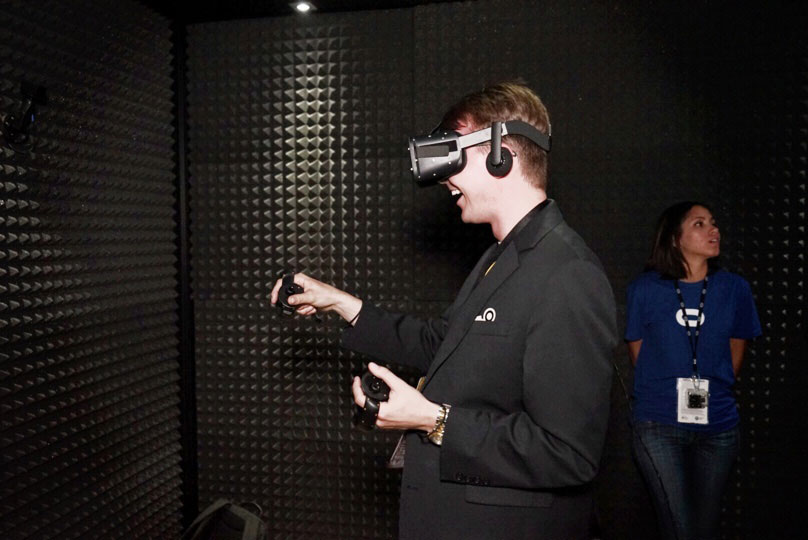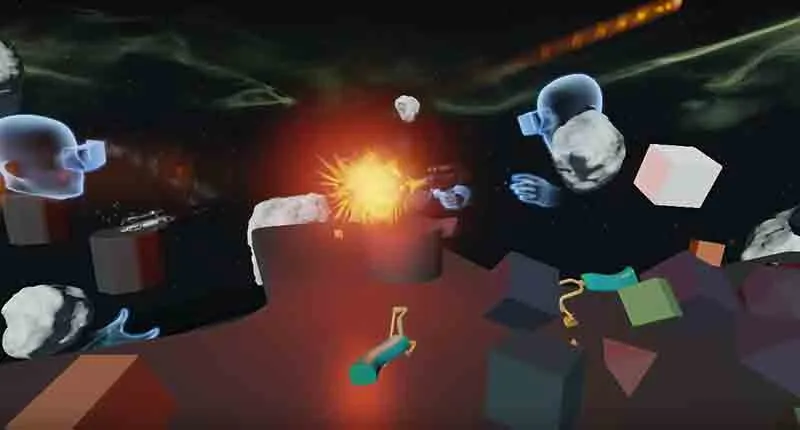When I first tried Oculus’ Toybox demo back in May I called it “one of the most fun times I’ve had in VR,” which it was, and still is today (although the VOID recently stole the title of ‘most immersive’). For me, it was the social interactivity in Toybox that really elevated the experience. Being able to play a game of tetherball with someone who wasn’t in the same physical space with me, to drive RC tanks that actually fired on each other and exploded, to shoot freaking ray guns at garden gnomes, all of it was pure magic.
In that moment I was a child again, except the things that only were possible in my imagination then were happening right before my eyes.

Oculus CEO Brendan Iribe recently released an extended look into Oculus Toybox on his Facebook account. Even though the video is from an observer’s position, it still manages to showcase just how much fun two people can have together in a world where the only rules are the ones you create together.
Oculus is placing a large amount of emphasis on socialization in VR, which can easily be painted as an isolating technology. In fact according to Jason Rubin, Oculus’ head of worldwide studios, the social aspect of VR was one of the reason’s the company aligned itself with Facebook:
“Even without the voice, I can tell you which one is which just by watching the hand gestures and the hand movement because we all have nuanced individual humanity, in the way that we move, and I can pick my friends out. Seeing that instance and that transmission of humanity is social on a level you really haven’t seen before. Not surprisingly, it’s the reason why we’re part of Facebook.”
As a part of their efforts to increase the amount of social VR in the ecosystem Oculus is planning to release a Social SDK in the near future which will add things beyond avatars and voice chat, “it is all the other things you need to be able to do.”
“A lot of people imagine social SDK to mean Facebook integration or something,” Palmer Luckey told me, “the reality is a lot of the core functionality of VR is inherently social.”
Read More: How virtual reality is going to humanize social media
One day we will likely see Facebook integration beyond 360º videos you can see in Gear VR, but it may be a while before we have the kind of metaverse that has been explored in science fiction novels like Ready Player One and Snow Crash. That is going to take VR reaching “critical mass,” according to Luckey. “You can’t have a metaverse until you have enough people to start seeing how it’s going to function,” he says.
But that is not to say that Oculus and Facebook are not working on building the metaverse themselves, it is a part of where the companies are headed in the next number of years, they just want to make sure when they do it they “get it right.”
“I think a lot of people understand that this time around and they’re looking at ways to keep things flexible,” says Luckey. “Just to toot our own horn, this is something we keep in mind. We’re not out there just trying to build something. If we wanted to, if it was really a priority, we could’ve made an app already. Call it Oculus metaverse and this is what it is. It could have been a glorified MMO with some really interesting functionality that ties into the functionality people expect from the metaverse. But we’d much rather work and get this right over a longer period of time than rush into it at the start and be constrained by the design decisions that we make.”
It may take a while for Oculus to feel secure in reaching that destination. “It’s not happening in the immediate future,” says Luckey, due to the rapid iterations in the architecture surrounding the new medium. “Once we put something out there, you have to support it. Once you’ve really made that significant time and effort into something, you can’t just throw it all away and move to some other architecture.”
https://www.youtube.com/watch?v=vEt1_uzAGI4
While Oculus is choosing to slowly develop its metaverse over the course to VR’s mass adoption, others like High Fidelity, Janus VR, and VRChat are already jumping in to fill the void. These applications are looking to create a social environment where users can jump from experience to experience together without leaving VR. There is also a strong emphasis on user creation within these ideals of the metaverse, and there has already been a lot of very interesting content created on each platform by the voracious VR community. Still, these companies will all face the same uphill battle first creating a large enough audience, and then scaling as VR reaches its critical mass.
Oculus realizes that in order for us to build towards a metaverse we need to acclimatize people to the idea that we can effectively communicate through this new medium, and that comes with socialization within specific experiences – hence the SDK.
When the Internet was first imagined by theorists like Marshall McLuhan, it was envisioned as a “global village,” a way that would connect everyone across the world enabling a new level of intimacy with our fellow man. It has taken over 30 years for that vision to go from Stanford students using it to buy weed from MIT students in the early-70s, to us having a billion people in one day logged into a single online social network (yes, the same one that bought Oculus). We have already become used to the idea as a society of communicating with someone who is not present in the space with you, it is only a matter of time before we are used to them being Present again. And when that happens, good things will likely come with it.




























